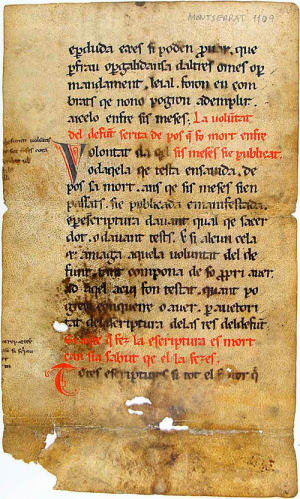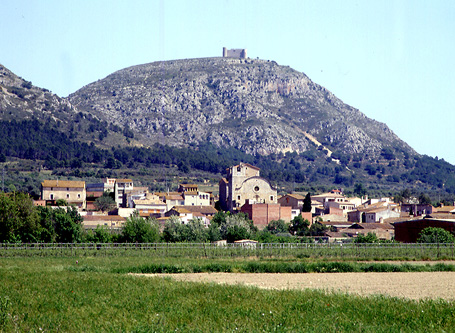Joan Vilaseca has just mentioned, in comments on the post before last, an instance from Carolingian Catalonia where the pope was called on to amend the Visigothic Law. I had seen this before, at the beginning of my Ph. D., and been reminded of it occasionally since, but while I was looking at the lack of evidence for Carolingian-era liturgical enforcement I had come across it again, and it’s such a peculiar episode it’s worth writing about as an instance of the way that early medieval law was often much more about satisfying competing requirements from those demanding settlement than about following what a lawyer might now say should have applied.1

It’s time for the most available image of a Catalan copy of the Law again! Abadia de Montserrat ([1]) [Public domain], via Wikimedia Commons.

A fourteenth-century depiction of King Louis II of France, missing star of this story; as far as I know there is no earlier picture of him surviving. By Anonymous [Public domain], via Wikimedia Commons
As the papal bull that records this tells it, Sigebod showed the pope a copy of ‘the book of Gothic law’, and stressed that there was nothing in it about sacrilege and that the book explicitly prohibited its judges from hearing cases about things that it didn’t cover (which indeed it does). We don’t know why Sigebod had brought this up now, but his complaint is clear: “thus the right of the holy Church was being suffocated by the provincial inhabitants of Gaul and Spain”. So they went to look for other law. First up, presumably because they were asking the pope, Bishop of Rome after all, was the “law of the emperor Justinian”, which laid down a penalty of five pounds of the best gold for sacrilege, but they found a more lenient prescription “that was constituted by the pious prince Charles”, a fine of thirty pounds of silver, “that is, 600 solidi of the purest silver”. There’s a range of reasons that’s odd, not the least of which is that that conversion is two-and-a-half times the usual reckoning of twenty solidi to the pound, but anyway, the pope preferred the lighter penalty, and further ordained that anyone not paying this fine will be excommunicated until they do. John concludes: “And we ordered that this law should be written at the end of the book of worldly law.”5

Actual Carolingian legislation from Catalonia, the Ripoll copy of Ansegis’s collection of capitularies, Archivo de la Corona de Aragón MS Ripoll 40, fo. 9r, from the PARES portal
A theoretically-minded lawyer would quite possibly find this very frustrating. Firstly, Catalonia is under a Carolingian king at this point, and as this council reveals there is Carolingian legislation that covers this, to which surely this area was theoretically subject. It’s not as if Carolingian legislation wasn’t known and used in the area, or known at least; we have copies of it from this era, as you see at right.6 All the same, that apparently didn’t work for Sigebod; he needed to be able to cite the Visigothic Law. Now, that confines the right to make legislation to ‘the prince’, which term surely encompasses whoever is in charge of the secular government.7 That, at this point, was surely King Louis, in whose very court they now stand, but it is not him they consult. And when the pope is consulted instead, his first port of call is not any local law, but the law of a man who had never ruled this area, Justinian I (though it is interesting to see Justinianic law in use here so early rather than the Codex Theodosianus or its derivatives). Admittedly, what they wind up with in the end is Carolingian law, all the same, so you could if you wanted to squint see this as an elaborate confirmation that the Carolingians have indeed replaced the old rulers of the Roman Empire, and if so then there’s no-one more fitting than the pope, whose predecessors had crowned the first Carolingian and raised Charlemagne to the rank of emperor, to make it apparent. But I don’t think that’s what was happening here, because Louis didn’t get to occupy that rôle; it wasn’t he who issued the new decree. He was thus neither emperor-substitute, even though he was son of the last emperor of the West, nor ‘prince’ of what his son would later call ‘our Gothic kingdom’.8
Let’s be as clear as we can: the king still ruled the area, or the relevant people wouldn’t have been asking about this at his council. At this same council, indeed, he would issue a precept to Bishop Frodoí of Barcelona, who was apparently there and whom you might think would be concerned with this legislation given the problems he apparently faced, confirming the rights of Barcelona’s cathedral, that same text which is first to mention the relics of Saint Eulalie being there.9 So the royal word and ruling was worth something still! Apparently not enough, though, for the king to be allowed to add to the Law of the Goths like the real princes of yesteryear. Instead, the pope, whom no-one would yet call a princeps, and the assembled churchmen in council with him, got to add to the “codex legis mundanae”. It seems then that royal authority in Catalonia was already fading into the half-light it occupied for the next century-plus here: it was useful, prestigious and traditional, but passive; it could not now do anything new any more, so for that new solutions were required. The one that was improvised here was not decisive, but it’s surprising. It surprises me not least because apparently Louis accepted this replacement of what we might think should have been his authority; only four years before, after all, his father was still dispatching missi to the Spanish March to check up on the misuse of royally-granted privileges.10 Louis’s position was weaker, but would Archbishop Sigebod really have dismissed it if Louis had issued a capitulary enforcing his great-grandfather’s rules once more? I don’t understand why it was the pope who got to do this, but I think that that fact shows us that something crucial had changed here, very recently.
1. The classic exposition of this view of early medieval law is Patrick Wormald, “Lex Scripta and Verbum Regis: legislation and Germanic kingship, from Euric to Cnut” in Peter Sawyer & Ian N. Wood (edd.), Early Medieval Kingship (Leeds 1977), pp. 105-138.
2. See now Jeffrey Bowman, Shifting Landmarks: Property, Proof, and Dispute in Catalonia around the Year 1000 (Ithaca 2004), pp. 33-55.
3. Rosamond McKitterick, The Frankish Kingdoms under the Carolingians (London 1983), pp. 258-259; cf. Janet L. Nelson, Charles the Bald (London 1992), pp. 250-255 for a more positive reading of the sources.
4. Ramon d’Abadal in de Vinyals, Els Primers Comtes de Catalunya, Biografies Catalanes: sèrie hist&oagrave;rica 1 (Barcelona 1958, repr. 1980), pp. 53-72; cf. now Joan Vilaseca, “Onze de setembre de 878” in idem, Recerques en la Alta Edat Mitjana Catalana (II) (Terrassa 2013), pp. 97-118; I haven’t made up my mind about this yet!
5. Ramond d’Abadal i de Vinyals (ed.), Catalunya Carolíngia II: els diplomes carolingis a Catalunya, Memòries de la Secció històrico-arqueològica 2 & 3 (Barcelona 1926-1952), 2 vols, ap. IX:
“… venit ante praesentiam nostram filius noster Sigebodus primae sedis Narbonensis episcopus cum suis suffraganeis episcopis, & detulit nobis librum Gothicae legis, ubi nihil habebatur de sacrilegiis; & in eisdem legibus scriptum erat ut causae quas illae leges non habent, non audirentur a judicibus illius patriae. Atque ita jus sanctae Ecclesiae suffocabatur ab incolis Galliae & Hispaniae provinciis. Unde nostra serenitas cum praescriptis episcopis, inespectus legibus Romanis, ubi habebatur de sacriliegiis, invenimus ibi a Justininiano imperatore legem compositionis sacrilegii constitutam, scilicet in quinque libras auri optimi. Sec nos leniorem legem praecipimus esse tenendam qua a Karolo est constituta pio principe de compositione sacrilegii, videlicet in triginta libras examinati argenti, id est, secxentorum [sic] solidorum argenti purissimi. Ideoque quisquis inventus fuerit reus sacrilegii, istam leviorem compositionem emendet ipsis episcopis vel abbatibis sive personis ad quos sacrilegii querimonia juste pertinuerit. Et si ipse reus sacrilegii facere noluerit, tamdiu excommunicationi subjaceat usquequo praedictam compositionem sexcentorum solidorum persolvat. Et si in hac obstinatione mortuus fuerit, corpus ejus cum psalmis et hymnis non deferatur ad sepulturam. Et praecipimus ut in fine codicis legis mundanae scribatur haec lex.”
6. Barcelona, Archivo de la Corona de Aragón, Manuscrits Ripoll 40, on which see M. E. Ibarbaru Asurmendi, “Translatio Sancti Stephani ab Hierosolymis Constantinopolim. Capitularia Regum Francorum (Arxiu de la Corona d’Aragó: Ms. Ripoll 40)” in Antoni Pladevall (ed.), Catalunya Romànica X: el Ripollès (Barcelona 1987), pp. 291-292.
7. Karl Zeumer (ed.), Leges Visigothorum, Monumenta Germaniae Historica (Leges Nationum Germanicum) I (Hannover 1902, repr. 2005), transl. S. P. Scott as The Visigothic Code (Boston 1922), II.1.XII.
9. Charles the Simple, in Abadal, Catalunya Carolíngia II, Elna IV.






